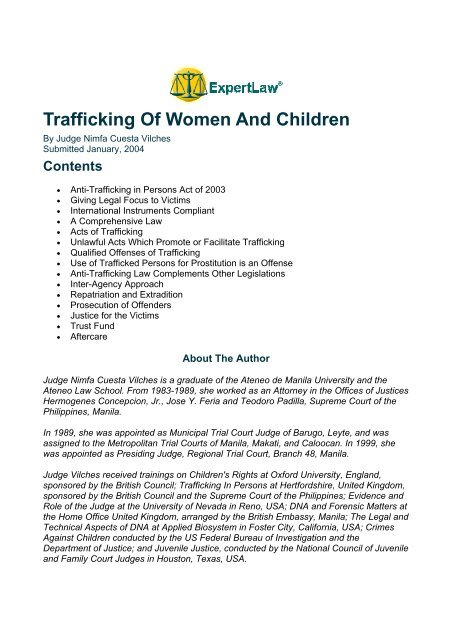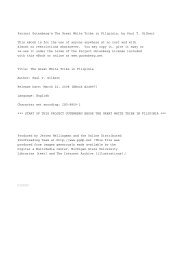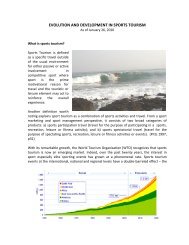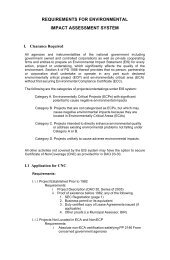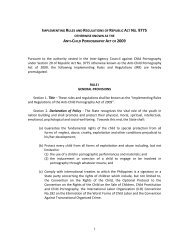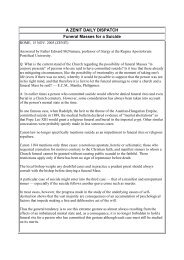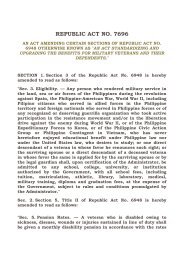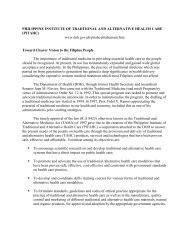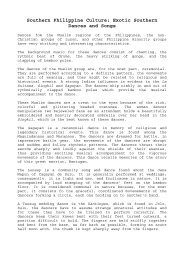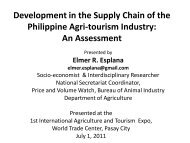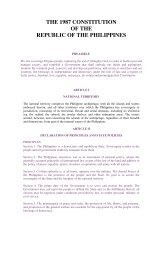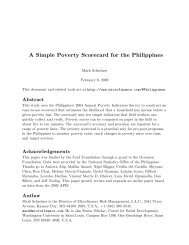Trafficking Of Women And Children
Trafficking Of Women And Children
Trafficking Of Women And Children
Create successful ePaper yourself
Turn your PDF publications into a flip-book with our unique Google optimized e-Paper software.
<strong>Trafficking</strong> <strong>Of</strong> <strong>Women</strong> <strong>And</strong> <strong>Children</strong>By Judge Nimfa Cuesta VilchesSubmitted January, 2004Contents• Anti-<strong>Trafficking</strong> in Persons Act of 2003• Giving Legal Focus to Victims• International Instruments Compliant• A Comprehensive Law• Acts of <strong>Trafficking</strong>• Unlawful Acts Which Promote or Facilitate <strong>Trafficking</strong>• Qualified <strong>Of</strong>fenses of <strong>Trafficking</strong>• Use of Trafficked Persons for Prostitution is an <strong>Of</strong>fense• Anti-<strong>Trafficking</strong> Law Complements Other Legislations• Inter-Agency Approach• Repatriation and Extradition• Prosecution of <strong>Of</strong>fenders• Justice for the Victims• Trust Fund• AftercareAbout The AuthorJudge Nimfa Cuesta Vilches is a graduate of the Ateneo de Manila University and theAteneo Law School. From 1983-1989, she worked as an Attorney in the <strong>Of</strong>fices of JusticesHermogenes Concepcion, Jr., Jose Y. Feria and Teodoro Padilla, Supreme Court of thePhilippines, Manila.In 1989, she was appointed as Municipal Trial Court Judge of Barugo, Leyte, and wasassigned to the Metropolitan Trial Courts of Manila, Makati, and Caloocan. In 1999, shewas appointed as Presiding Judge, Regional Trial Court, Branch 48, Manila.Judge Vilches received trainings on <strong>Children</strong>'s Rights at Oxford University, England,sponsored by the British Council; <strong>Trafficking</strong> In Persons at Hertfordshire, United Kingdom,sponsored by the British Council and the Supreme Court of the Philippines; Evidence andRole of the Judge at the University of Nevada in Reno, USA; DNA and Forensic Matters atthe Home <strong>Of</strong>fice United Kingdom, arranged by the British Embassy, Manila; The Legal andTechnical Aspects of DNA at Applied Biosystem in Foster City, California, USA; CrimesAgainst <strong>Children</strong> conducted by the US Federal Bureau of Investigation and theDepartment of Justice; and Juvenile Justice, conducted by the National Council of Juvenileand Family Court Judges in Houston, Texas, USA.
The professional qualifications of Judge Vilches are: Professor, Ateneo Law School andrecipient of the Chief Justice Ramon Avecena Professorial Chair in Civil Law for the year2003-2004; a Member of the Faculty and Research Group of the Philippine JudicialAcademy (PhilJA), Supreme Court; Lecturer for the UP Law Center and Institute of JudicialAdministration UP-IJA) to train Nepal judges and justices, the Integrated Bar of thePhilippines (IBP) and the Public Attorneys <strong>Of</strong>fice (PAO) for the mandatory continuing legaleducation program, and gives trainings for UNICEF.In May 2002, Judge Vilches was chosen as a Member of the Philippine Delegation to theUN Special Session for <strong>Children</strong> in New York, USA; was a Delegate-Rapporteur to the 1stAustralasian Judicial Forum in Manila in January 2003, and was a Delegate-Rapporteur,Asia-Europe Experts Meeting in Manila in March 2003. In August 2003, Judge Vilches waselected Chair of the Task Force on Justice for <strong>Children</strong>, Council for the Welfare of<strong>Children</strong>, <strong>Of</strong>fice of the President.Judge Vilches has written the articles "DNA <strong>And</strong> The Courts" and "Are You Ready To Be ACASA/GAL Volunteer?" which have been widely published locally and internationally. In1999, she started a program in the country called CASA/GAL composed of trainedcommunity volunteers who promote the best interests of children in court. CASA/GAL wasvoted by UNICEF as one of the ten best practices in Asia. Judge Vilches has also written abook on "B.P.22: FAQs" published by Rex Bookstore which is for release soon.Since the promotion of Judge Vilches to the Regional Trial Court of Manila in February1999, she has topped in the number of cases disposed with a least average of 30 casesper month.A girl child in the Philippines is discriminated upon early in life due to culture-based andfamily reinforced gender biases. For instance, despite her special nutritional needs inpreparation as future mother and nurturer, the girl child is allotted less food than her fatherand her brothers. When money for education is scarce, her brothers are given thepreference.The Filipino girl child takes the stereotyped role of her mother who is portrayed as anabused and submissive woman relegated to domestic work. Moreover, the publicconsiders girls and women as sex objects and typifies them as club/bar entertainers,beauty pageant contestants, and racy or pornographic film stars.The pejorative expectations that Filipino society has on women and children arecompounded by problems of extreme poverty; massive labor export; globalization; porousborders; aggressive tourism campaigns; negative portrayal of women by mass media;pornography on-line and internet chat-rooms; the practice of mail-order brides; intercountryadoption; and joint military exercises in the country with visiting forces fromabroad. These factors cause women to become easy victims of sex-trafficking and otherforms of sexual exploitation either in the Philippines or in countries of destination.To date, more than 4 million Filipinos are unemployed and 40% of them are women. Therewere around 600,000 prostitutes in the Philippines in the year 2000 and 50,000 of themwere children. In September 2002, a staggering number of 1.6 million Filipinos left the
country to work abroad and 48% of them are female. In the first quarter of the year 2003,there were 2,872 sexually abused and exploited children. Further, the number of girlchildren in the year 2000 which was estimated at 16.7 million will significantly increase to17.4 million in 2005.Anti-<strong>Trafficking</strong> in Persons Act of 2003For a considerable length of time, trafficking and sexual exploitation of women andchildren hardly mattered to the Filipino man and woman. This in turn made it difficult forthe victims to seek redress in court for the violence and abuses committed against them.But with the sex trade reaching global proportions, the Philippine legislature was promptedto enact Republic Act 9208 or the "Anti-<strong>Trafficking</strong> in Persons Act <strong>Of</strong> 2003" on 26 May2003.Giving Legal Focus to VictimsThe anti-trafficking law is a milestone in the promotion of human dignity and protection ofpersons specially women and children against any threat of violence and exploitation. Itseeks to eliminate trafficking; the establishment of necessary institutional mechanisms forthe protection and support of trafficked persons; and provides penalties for violations of thelaw.Trafficked persons outside of the Philippines fall under the category of "overseas Filipino indistress" entitled to all legal assistance extended by the Migrant Workers and OverseasFilipinos Act. Additionally, the anti-trafficking law recognizes that trafficked persons arevictims and as such, are not penalized for crimes directly related to any act of trafficking.As a consequence, consent of the trafficked person to the intended trafficking is assumedto be irrelevant.International Instruments CompliantProviding a strong framework for the anti-trafficking law are universally acceptedinstruments and conventions to which the Philippines is a signatory, among which are: theUnited Nations Universal Declaration on Human Rights; United Nations Convention on theRights of the Child; United Nations Convention on the Protection of Migrant Workers andTheir Families; United Nations Convention Against Transnational Organized Crimeincluding its Protocol to Prevent, Suppress and Punish <strong>Trafficking</strong> in Persons Especially<strong>Women</strong> and <strong>Children</strong>; and the Convention on the Elimination of All Forms of DiscriminationAgainst <strong>Women</strong>.A Comprehensive Law<strong>Trafficking</strong> under the new law is interpreted in its broadest sense. It refers to recruitment,transportation, transfer or harboring, or receipt of persons with or without the victim'sconsent or knowledge, within or across national borders by means of threat or use of force
or other forms of coercion, abduction, fraud, deception, abuse of power or of position,taking advantage of the vulnerability of the person.<strong>Trafficking</strong> also means the giving or receiving of payments or benefits to achieve theconsent of a person having control over another person for the purpose of exploitationwhich includes, at a minimum, the exploitation or the prostitution of others or other forms ofsexual exploitation, forced labor or services, slavery, servitude or the removal or sale oforgans.Nationals of foreign countries who are trafficked in the Philippines come within the purviewof the law. Such persons are entitled to the same protection, assistance and servicesgiven to trafficked Filipinos. The foreign nationals are permitted continued presence in thecountry for a length of time as necessary to effect prosecution of offenders.Acts of <strong>Trafficking</strong>The following are deemed acts of trafficking committed either by a person or an entitywhen done for the purpose of prostitution, pornography, sexual exploitation, forced labor,slavery, involuntary servitude or debt bondage: (a) to recruit, transport, transfer, harbor,provide or receive a person on the pretext of domestic or overseas employment, training orapprenticeship; (b) introduce or match for a consideration any Filipino woman to a foreignnational for marriage for the purpose of trading her for prostitution; (c) offer or contractmarriage; (d) undertake or organize tours and travel plans; (e) maintain or hire a person;and, (f) adopt or facilitate adoption.Any undue recruitment, hiring, adoption, and movement of persons and children forremoval or sale of organs or for the children to engage in armed activities in thePhilippines or abroad are also considered acts of trafficking.Unlawful Acts Which Promote or Facilitate <strong>Trafficking</strong>A person may be held liable under the law for promoting or facilitating trafficking by doingany or a combination of the following acts: (a) knowingly lease space or building; (b)furnish fictitious certificates to comply government regulatory and pre-departurerequirements; (c) publish propaganda materials; (d) assist in the exit and entry of personsfrom/to the country with fraudulent documents; (e) deprive or destroy passports andpersonal documents to prevent trafficked persons from leaving the country and forobtaining assistance; or (f) knowingly benefit services from persons held to a condition ofinvoluntary servitude, forced labor or slavery.All those who create demand for trafficking of women and children that usually results inprostitution are punished under the above provisions of the law.Qualified <strong>Of</strong>fenses of <strong>Trafficking</strong>No less than a penalty of life imprisonment and a fine of not less than P2 million is inflictedon the offender in special instances of trafficking such as follows: (a) when the trafficked
person is a child [below 18 years old or over but unable to care of self]; (b) when adoptionis effected under the Inter-Country Adoption Law; (c) when committed by a syndicate[group of 3 or more persons in conspiracy] or in large scale [against 3 or more persons];(d) when committed by a person exercising parental authority over the victim or by a publicofficer or employee; (e) when trafficked person is recruited to engage in prostitution withmilitary or law enforcement agencies; (f) when offender is a member of the military or lawenforcement agencies; and (g) when by reason or on occasion of the trafficking, the victimdies, becomes insane, suffers mutilation or is afflicted with human immunodeficiency virus(HIV) or the acquired immune deficiency syndrome (AIDS).Worthy of note at this juncture is the recent effort of the Philippine Government to includeas predicate crime under the Anti-Money Laundering Law child prostitution. Predicatecrimes are those which would trigger immediate investigation by the anti-money launderingcouncil making it easier to stop the flow of money from illegal activities.Use of Trafficked Persons for Prostitution is an <strong>Of</strong>fenseAny person who buys or engages the services of trafficked persons for prostitution ispenalized with 6 months of community service and a fine of P50,000 for the first offense.An imprisonment and fine of P100,000 are imposed for the second and subsequentoffenses.Anti-<strong>Trafficking</strong> Law Complements Other LegislationsThe anti-trafficking act reinforces related laws such as Republic Act 7610 on the SpecialProtection of <strong>Children</strong> Against Child Abuse, Exploitation and Discrimination; Republic Act7658 Prohibiting the Employment of <strong>Children</strong> Under Fifteen Years Old; Republic At 7877on Anti-Sexual Harassment; Republic Act 8042 on Migrant Workers and OverseasFilipinos; Republic Act 8043 on Inter-country Adoption; Republic Act 8353 or the Anti-RapeLaw; and Republic Act 8505 on Rape Victim Assistance and Protection.Inter-Agency ApproachAn Inter-Agency Council Against <strong>Trafficking</strong> is established under the new law. It is chairedby the Secretary of Justice and co-chaired by the Secretary of the Department of SocialWelfare and Development. The other members are heads of the departments on foreignaffairs, labor, overseas employment, immigration, law enforcement; commission on therole of women; and 3 representatives from NGOs.Among the important functions of the Council are: (a) to formulate programs that willprevent trafficking; (b) promulgate rules and regulations to implement the law; (c) monitorstrict implementation; (d) coordinate inter-agency projects; (e) conduct massiveinformation campaign; (f) direct other agencies to immediately respond to problems oftrafficking; (g) assist in the filing of cases against offenders; (h) formulate programs forreintegration of trafficked persons; (i) secure assistance from government and NGOs toimplement the law; (j) share information and have continuing research on the patterns andschemes of trafficking; and (k) initiate training programs.
Repatriation and ExtraditionTrafficked Filipinos abroad are repatriated regardless of whether their travel to anothercountry is documented or not. But if repatriation will expose the victim to greater risks, thePhilippines make representations with the host country for an extension of residencypermit and protection. However, trafficking in persons shall be included among extraditableoffenses.Prosecution of <strong>Of</strong>fendersAny person with actual knowledge of trafficking may initiate a complaint in the court wherethe crime was committed or where the victim resides. If the offended party decides to file aseparate action for damages resulting from the act of trafficking, no court fees are requiredto be paid.The victim has a period of 10 years within which to commence a criminal complaint. Wheretrafficking is carried out by a syndicate or when done in large scale, the period toprosecute is 20 years from the time the victim is released from the conditions of bondage.Pursuant to the Rape Victim Assistance and Protection Act, the investigation of offensescommitted against women must be handled by an all-female team of police officers,examining physicians and prosecutors. Protective measures such as the right to privacyand closed-door investigations are accorded to the victim.The personal circumstances of the trafficked victim are not to be disclosed to the publicand the investigation is conducted in a language known or familiar to the victim. Everytrafficked woman or child enjoys preferential entitlement to the benefits under Republic Act6981 or the Witness Protection Program.When the persons trafficked are children, the Special Protection of <strong>Children</strong> Act and theRule on Examination of a Child Witness mandate that there must only be a single interviewby a multidisciplinary group of professionals recorded in audio or video tape. In this way,the child victim does not suffer the damaging effect of feeling re-victimized through aseries of repeated questioning.Justice for the VictimsInside the courtroom, a child victim is presumed to be a competent witness and is entitledto the services of support persons such as a trained child advocate or a guardian ad litem.If there is a substantial likelihood that the child will suffer trauma from testifying in front ofthe offender, the Rule on Examination of a Child Witness provides for alternative ways totestify such as by live-link television or video-taped deposition.When women or girls are the offended parties, the "sexual shield rule" bars the offenderfrom offering evidence which tends to establish the fact that the victims engaged in othersexual behaviors or show proof of their sexual predisposition. This demonstrates good
court practice by way of being gender and child sensitive when dealing with cases onwomen and children.Philippine courts are likewise venturing into the use of DNA forensic evidence to provesexual offenses against very young child victims whose testimonial capacities are limitedand inadequate. The judges are altogether open to the idea of knowing how a set ofbehavioral patterns common to victims of violence against women and children like the"battered woman syndrome" and the "child sexual abuse accommodation syndrome"would impact court dispositions of trafficking offenses.When child victims are involved, the Rule on Examination of a Child Witness allows thecourt to accept hearsay evidence. Medical certificates are not required to commence acriminal case of sexual abuse neither are such evidences necessary to make a finding ofguilt.The anti-trafficking law clearly outlines the penalty and fine to be imposed on the offender.It further authorizes the court to order the confiscation and forfeiture of the proceeds andinstruments derived from trafficking.Where the offender seeks on appeal to a higher court a reduction of the penalty applied,appellate courts adopt the policy of according weight to the findings of the lower courtjudges who were in the best position to observe the demeanor of the parties.Trust FundAll fines imposed by the courts on the offender and the proceeds or properties forfeitedused in trafficking accrue to a Trust Fund which is administered by the Inter-AgencyCouncil Against <strong>Trafficking</strong>. The fund is utilized exclusively for programs that prevent actsof trafficking; protect and rehabilitate the victim; and reintegrate trafficked persons into thecommunity.Aside from the mandatory services which have to be made available to victims oftrafficking, programs that are on priority list of the of the Trust Fund are research and datacollection; technical support to government and non-government organization (NGOs);seminars for consensus building; and awareness raising regarding trafficking in persons.AftercareFinally, to ensure the recovery and re-entry of the victim to the community, courts directgovernment agencies to make available the mandatory services contemplated by the antitraffickinglaw which are as follows: (a) emergency shelter or housing; (b) counseling; (c)free legal services; (d) medical or psychological services; (e) livelihood and skills training;and (f) educational assistance to a trafficked child.


